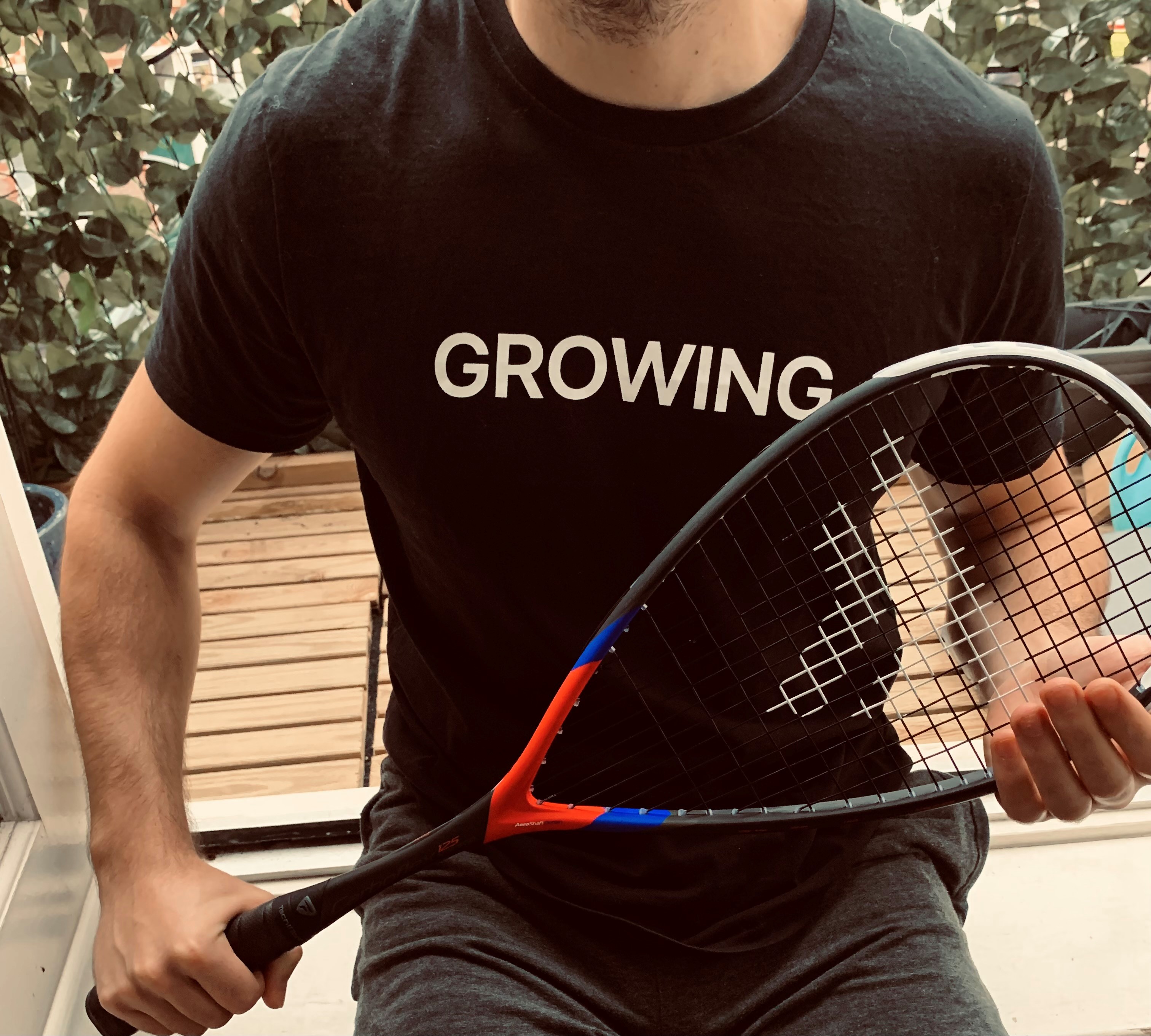This post may contain affiliate links.

Since you are reading this, it might be hard to consider, but squash is not a well-known sport in every country. With that presupposition in mind, I wanted to answer the question: is squash still a growing sport?
On average squash is globally a growing sport in terms of the number of players, market size, and exposure, however, there are geographical differences. Technology makes exposure scalable to support the market size and number of enthusiasts.
Squash is still a growing sport, but what does this tell us, not much I would say. Let’s dive deeper and look at growth from three different angles: number of players, market size, and exposure.
Total number of players
Squash is still growing in popularity around the world and is played by 20 million people in over 130 countries on around 50,000 courts.
people in over 130 countries on around 50,000 courts.
On a recreational level squash is also becoming more popular to a wider audience, explained by the number of courts and the sales of beginner and intermediate squash rackets.
From a professional point of view, the sport is also growing. Every year more players are competing in Professional Squash Association (PSA) tournaments. The World Squash Federation is the global squash governing body and has 150 national squash associations as members. These members are grouped into five regions; Africa, Asia, Europe, Oceania, Pan America.
is the global squash governing body and has 150 national squash associations as members. These members are grouped into five regions; Africa, Asia, Europe, Oceania, Pan America.
But does this mean that there are around 385 courts in each country? No, certainly not and as you may have guessed, squash is definitely more popular in some countries while less in others. Let us try to unpack these figures by looking at the specifics within each WSF region.
Squash is still growing in popularity around the world and is played in 130 countries on around 50,000 courts.
Pan America
The WSF region that covers the Americas is called Federacion Panamericana de Squash and supports 2 million active squash players. Several initiatives are held to ensure everyone is able to play squash. It also allows athletes to get into universities and colleges.
The United States is within the region the main contributor when it comes to the number of squash players. According to market research by Fact.MR , squash grew in terms of the number of total players (80%), as well as the number of junior squash players (400%) between 2012 and 2017. Looking at a longer timespan, the number of players almost tripled (from 500,000 to 1.49 million) in just over a decade.
, squash grew in terms of the number of total players (80%), as well as the number of junior squash players (400%) between 2012 and 2017. Looking at a longer timespan, the number of players almost tripled (from 500,000 to 1.49 million) in just over a decade.
The exponential growth amongst juniors may be partially explained by the initiatives within the education system. They are also more encouraged to involve in squash since many high schools and universities provide opportunities to play squash. For example, the number of high school championships is growing alongside the total growth in the US. Another contributor to the growth includes new squash facilities at high schools and universities.
South American countries such as Colombia are showing potential to further grow in the future, mainly through hosting tournaments in several cities and investing in the promotion of the sport. With more professional Latin players playing on the highest podium, the interest will probably grow even further.
The United States is within the region the main contributor when it comes to the number of squash players.
Europe
The biggest portion of squash players in Europe (governed by the European Squash Federation) is coming from the United Kingdom. This seems logical since squash is originating from the UK. Over the years squash remains fairly popular, while there are several sounds that it might be declining. Nevertheless, 269,000 players in 2020 seem not too bad.
In both Italy and France, the number of squash players is expected to grow due to national efforts in promoting the sport. For example, in the Netherlands national top players are receiving a financial contribution to encourage them to pursue squash as their career.
According to a study , Finland is growing as a squash-playing country with almost 500,000 enthusiasts. The rise in popularity is mainly attributed to the awareness of the general population as a consequence of national initiatives.
, Finland is growing as a squash-playing country with almost 500,000 enthusiasts. The rise in popularity is mainly attributed to the awareness of the general population as a consequence of national initiatives.
Oceania
Squash is rather popular in Australia with around 1,600 squash courts. Nevertheless, the number of squash players in Australia is declining, mainly amongst non-regular players. Between 2011 and 2018 the total number of squash players dropped from over 300,000 to nearly 100,000.
On average 75,000 people in New Zealand play squash and around 25% of those players have a membership. Besides, both New Zealand and Australia are having programs in place to develop squash players. However, if you look at the figures provided by the Oceania region, the number of participants is declining. Therefore most squash players in Oceania are likely to come from either Australia or New Zealand.
Asia
Pakistan has been a leading Asian country when it comes down to internationally performing squash players. Nevertheless, there are many countries on the rise when it comes to the number of players. In Singapore, the number of squash players grew by 66.6% in over a decade which makes it a market that shows great potential. This might be explained by the fact that Singapore is hosting numerous tournaments.
Malaysia, another country with growth potential, despite the fact that the market is still small. Former squash player, Nicol David has put Malaysia internationally on the map and may result in a national growth in interest. Overall, Asia shows potential due to hosting PSA tournaments at several iconic locations, such as Shanghai and Hongkong.
Africa
The most famous country when it comes to the number of world-class squash players. Yes, that is right, Egypt.
Egypt is the birthplace of many world champions, which has sparked the number of squash participants. Another boost to this popularity might be explained by the fact that several hosted tournaments are played in several locations across Egypt. The most iconic being the venue next to the Giza pyramid of course.
South Africa, a promising country for growth is also the headquarters of the Squash Federation of Africa. South Africa is making an effort to increase the popularity and development of squash players through several programs. These programs focus on organizing tournaments and partnering with schools.
Market size
Another measure to gauge the growth of the sport is the number of squash racket sales. According to market research , the squash racket market has grown worldwide. Between 2014 and 2019 the market increased by 17.7% from $ 188.4 million to $ 221.7 million. From there it is expected to annually grow at 4%.
, the squash racket market has grown worldwide. Between 2014 and 2019 the market increased by 17.7% from $ 188.4 million to $ 221.7 million. From there it is expected to annually grow at 4%.
Fact.MR concluded that Europe was leading the squash racket market, capturing $ 58.6 million in 2019. However, around 2030 North America is expected to surpass and take over this leading position. While Europe captures 26.4% of the market and North America growing at a rapid rate, there are others to consider. For example, South East Asia captured around 4% of the total squash racket market in 2019 and is expected to grow moving towards 2030.
Despite the fact we noticed a decline in the number of squash players, the squash racket market is expected to grow in Australia and New Zealand. They are considered the largest and fastest-growing markets in that region, capturing over $ 15 million in 2020.
A mere generic trend in the squash racket market is pertaining to the type and used materials of squash rackets. There is a shift from heavier rackets to lightweight rackets. By 2030 lightweight racket is expected to contain 85% of the total squash racket market. Also, many squash racket manufacturers are using lighter materials, supporting the trend towards lightweight rackets. If you want to know more about the benefits of a lighter racket, check out this article .
.
North America is expected to surpass and take over this leading position.
Exposure
In the interconnected world, as we know it today, it is easier to get exposure than ever before. While exposure was previously limited to local initiatives or television broadcasting, nowadays initiatives reach beyond borders and online broadcasting is more popular.
As we have seen the total number of squash players is increasing, however, squash has also grown from a professional point of view. More professional players are competing in both national and international tournaments. Alongside this growth comes the growing number of spectators and interest from sponsors. From there, tournaments hosted by the PSA were broadcast on several television stations. Making use of the scalability that technology offers, live streaming of these matches was introduced in 2019. As a consequence, SquashTV was developed by the PSA to enable viewers to gain access to all matches through a paid membership. In order to introduce squash to a larger population, many clips of PSA tournaments are posted on YouTube or other social media platforms. A study  demonstrated that the number of views, as well as the number of subscribers, peaked during match days.
demonstrated that the number of views, as well as the number of subscribers, peaked during match days.
Another opportunity to reach a larger audience is famous people. Just like in any sport, any internationally renowned player is a boost to the national interest in squash. Besides famous squash players, there are numerous others that contribute to the growth. For example, famous tennis player Roger Federer is partaking in several initiatives to make squash more popular. But also former Dutch football legend Marco van Basten is promoting squash in the Netherlands.
Finally, if squash will become an Olympic sport, it will grow substantially. Over 3 billion people watch the Olympic Summer Games, this would definitely boost their exposure to the general population. On top of that, many tournaments are hosted at iconic locations around the world. The combination of spectacular venues, many spectators and live streaming makes squash a sport with growth potential.
While exposure was previously limited to local initiatives or television broadcasting, nowadays initiatives reach beyond borders and online broadcasting is more popular.

